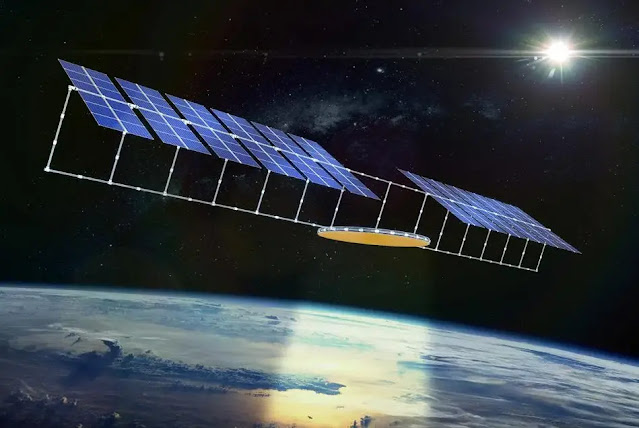Establishing solar power stations in space will provide us with advantages that terrestrial stations cannot provide, but this requires overcoming many challenges.
About two decades ago, the US National Aeronautics and Space Administration (NASA) submitted a proposal to establish solar energy stations in space. This project has not been completed to this day, and the US agency has no plans or funds allocated for the implementation of the project.
Solar electric station
Recently, many governments and companies have begun to cooperate with each other to establish solar stations in Earth's orbit, and these stations may be in service within several decades.
British government project
The UK government has commissioned several companies and researchers to research and study a project to launch a large satellite worth £16 billion ($19.2 billion) carrying lots of lightweight solar panels.
The research focuses on the solar panels on this moon capturing the abundant sunlight in Earth's orbit, and then sending it in the form of high-frequency radio waves to a fixed point on Earth equipped to receive it.
Solar pumping station
This project is one of the projects to be proposed in the Net Zero Innovation Portfolio. To enable the UK to achieve net zero emissions by 2050.
The proposed satellite is 1.7 kilometers in diameter and weighs about 2,000 tons. It is expected to provide 2 gigawatts of electric power to the UK. While this is a large amount, it is only a small part of the energy needs of the UK, which is around 76 gigawatts.
With very high initial costs and slow return on investment, the project will require significant government resources as well as massive investment by private companies.
China project
China plans to launch an ambitious program to build a space solar power station in 2028, according to scientists involved in the project. In order to test the capability of wireless power transfer from space to Earth at a height of 400 km, a satellite will be launched that year. The Chinese Academy of Aerospace Technology (CAST), a leading state-owned spacecraft manufacturer, plans to experiment with high-voltage wireless transmission from low-Earth orbit in 2028.
The basic concept behind this technology is to create a space station with solar panels that convert solar energy into electricity, then a radio transmitter or laser emitter transmits the energy to Earth.
The China project is very small in size compared to the UK project, but it may be the beginning of more ambitious future projects once the idea matures.
How will the solar power station work in space?
This station is a satellite equipped with lightweight solar panels to make it easier to carry into space. These panels will capture the sun's rays and convert the thermal energy in these rays into electrical energy, then the electrical energy will be transmitted wirelessly to the earth through high-frequency radio waves. On the ground, a large terrestrial antenna will receive these waves and convert them into electricity again, then connect the electricity to the local electric power grid.
Building a solar power station in space is a feasible project for several reasons, the most important of which is that we have the technologies necessary to implement this project, such as lightweight solar panels, advanced spacecraft, and robots capable of installing and repairing them in orbit, in addition to effective ways to transfer energy wirelessly from space to Earth. without losing or squandering it.
Advantages offered by space solar power plants
The reason why the establishment of solar energy stations in space is better than on Earth is the presence of the atmosphere surrounding the Earth, which loses solar radiation a large part of its energy. To estimate this effect, it is enough to know that solar panels on Earth receive only 1% of the solar energy that the same panels can receive in space.
In addition, the establishment of solar power plants in space will help in delivering electricity to any place on Earth easily, and this is very useful in remote areas that do not reach electricity services, or in places of natural disasters and wars.
The stations in space will not be affected by weather fluctuations and the presence of clouds that block solar radiation, and they can work throughout the day by always staying in the area facing the sun, meaning that they will not stop working at night due to the absence of the sun.
Criticism of these projects
Although the goal of space solar power stations is to reduce greenhouse gas emissions and their impact on the climate, assembling one station in space will require many spacecraft launches, and as it is known, the launch of these vehicles leads to the emission of a lot of harmful gases, and they are also too expensive.
But the American company "SpaceX" succeeded in reusing space vehicles after their launch, which led to a revolution in the field of space conquest, as the ability to reuse launch vehicles will reduce the total cost of establishing a solar power station in Earth's orbit, in addition to to reduce its impact on the environment.
The project to establish a solar power station in space faces many challenges that must be overcome, but these stations may be an introduction to advanced and exciting research opportunities. In the future, this technology is likely to play an important role in the global energy supply and provide a permanent and renewable source of energy that replaces the use of fossil fuels.



Comments
Post a Comment